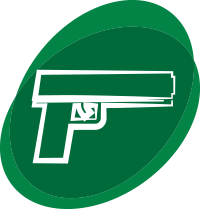Open proficiency tests meet accreditation requirements and measure examiner competence but may not represent actual casework. In December 2015, the Houston Forensic Science Center began a blind quality control program in firearms examination. Mock cases are created to mimic routine casework so that examiners are unaware they are being tested. Once the blind case is assigned to an examiner, the evidence undergoes microscopic examination and comparison to determine whether the fired evidence submitted was fired in the same firearm. Fifty-one firearms blind cases resulting in 570 analysis and comparison determinations were reported between December 2015 and June 2021. No unsatisfactory results were obtained; however, 40.3% of comparisons in which the ground truth was either elimination or identification resulted in inconclusive conclusions. Due to the quality of some of the evidence submitted, inconclusive results were not unexpected. A ground truth of elimination and comparison result of inconclusive was observed at a rate of 74%, while a ground truth of identification and comparison result of inconclusive was observed at a rate of 31%. Bullets (61.8%) were the main contributors to inconclusive conclusions; variables such as the assigned examiners, training program, examiner experience, and the intended complexity of the case did not significantly contribute to the results. The program demonstrates that the quality management system and firearms section procedures can obtain accurate and reliable results and provides examiners added confidence in court. Additionally, the program can be tailored to target specific research questions and provide opportunities for collaboration with other laboratories and researchers.
Blind testing in firearms: Preliminary results from a blind quality control program

Conference/Workshop:
Annual Scientific Conference of the American Academy of Forensic Sciences
Annual Scientific Conference of the American Academy of Forensic Sciences
Journal: Journal of Forensic Sciences
Published: 2022
Primary Author: Maddisen Neuman
Secondary Authors: Callan Hundl, Aimee Grimaldi, Donna Eudaley, Darrell Stein, Peter Stout
Type: Publication
Related Resources
Forensic Toolmark Comparisons
Forensic practitioners determine whether two marks were generated by the same tool by observing the 2D images of the marks using a comparison microscope and deciding whether the “surface contours…
Effect of Subclass Characteristics on Congruent Matching Cells (CMC) Algorithm
This presentation is a continuation of subclass characteristics present on consecutively manufactured breech face inserts. The objective is to assess manufacturing methods similar to those used by firearm manufacturers. It…
What’s in a Name? Consistency in Latent Print Examiners’ Naming Conventions and Perceptions of Minutiae Frequency
Fingerprint minutia types influence LPEs’ decision-making processes during analysis and evaluation, with features perceived to be rarer generally given more weight. However, no large-scale studies comparing examiner perceptions of minutiae…
Diagnostic Tools for Automatic Cartridge Case Comparisons
The following was presented at the Association of Firearm and Tool Mark Examiners (AFTE) 2023, Austin, Texas, May 21-26, 2023. Copyright 2023, The Authors. Posted with permission of CSAFE.


